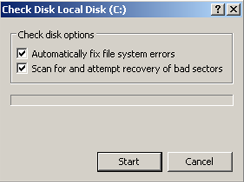

Without any parameters (I’ll describe a few in a moment), CHKDSK does nothing more than check the disk. Close Command Prompt (either by clicking the “x” in the upper-right of the Window, or typing “exit” followed by the Enter key), and start it again, this time being sure to select the “(Admin)” version listed, or right-clicking on the Command Prompt menu item and selecting “Run as administrator”. You’ve not run Windows Command Prompt as administrator. You have to invoke this utility running in elevated mode. If you see something like this: C:\WINDOWS\system32> CHKDSKĪccess Denied as you do not have sufficient privileges. Try it now: after opening a Command Prompt window or clicking it to make it active, type CHKDSK followed by the Enter key. Any output the tool generates shows up in the window below your typing. Running Command Prompt will open a new window that looks like this: Windows Command Prompt.Ĭommand line tools are run by typing the command and pressing the Return or Enter key. Make sure to right-click on the entry and select “Run as Administrator”. In prior versions of Windows, you’ll find Command Prompt under All Programs – Accessories, or by searching for “Command”. Once again, be sure to run the “(Admin)” version. You may instead see “Windows PowerShell” instead of Command Prompt. Command Prompt (Admin) in the Windows Start menu.
HOW TO RUN A DISK CHECK WINDOWS 7 FULL
You’ll want the “(Admin)” version so it runs with full administrative privileges. In Windows 10, right-click the Start menu, and it should be listed right there. You’ll find Command Prompt in your Start menu.

To run CHKDSK, we start with a Command Prompt. They rely on the Windows “Command Prompt”, which is nothing more than a non-windowed environment that mimics the days before Windows, when all programs were “command line” tools under MS-DOS. They don’t know about on-screen windows and don’t display their results in them. Most programs in Windows appear as … well, as (or in) a window.Ĭommand line tools do not. Unfortunately, a variety of errors can cause it to be incorrect - things like not shutting down your computer properly, removing USB devices without using Safely Remove, malware, or just flat out hardware errors can cause problems in the administrative information on the hard disk.ĬHKDSK’s job is to try to repair those errors. The system is designed to keep it correct from startup to shutdown. Normally, all of that information is correct. CHKDSK’s primary job is to make sure all of the administrative information about the files, folders, and other stuff stored on the disk is correct. There’s a lot of information on the hard disk to help keep track of all of the data being stored there. All you probably care about is that you get what you expect when you access a file. On top of that, there may be security information about who is allowed to access what and in what ways they’re allowed to access it.Īs you can imagine, things get pretty confusing.
HOW TO RUN A DISK CHECK WINDOWS 7 HOW TO
I’ll also show you how to run CHKDSK step by step.įiles on your hard disk live in folders folders can live in other folders the whole mess lives in your disk, which might actually be a partition on a larger hard disk. I’ll talk about what I mean by command line, and what it means to check a disk. It’s easy for us computer geeks to take things for granted that we shouldn’t.ĬHKDSK is a command line tool that checks disks.


 0 kommentar(er)
0 kommentar(er)
